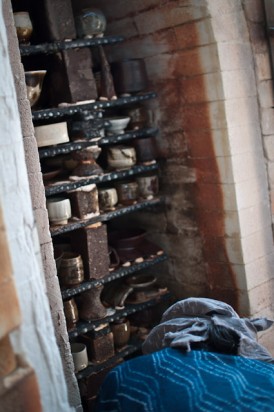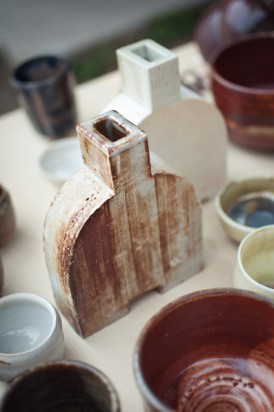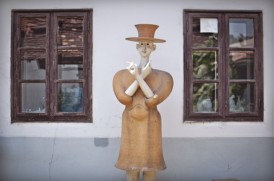Kecskeméti Nemzetközi Kerámia Stúdió / International Ceramics Studio
 The Artists Settlement was founded involving restless young artists in 1978. The city council (that is, the state) provided substantial funding. Although filtered, the Western ideology was able to arrive to the ‘happiest barrack of the Communist Camp’, to Hungary. Kecskemét has quickly had its place on the international map of the fine and applied arts, having artists to flock there. The 3000-piece collection of 400 artists from 42 countries is a national treasure.
The Artists Settlement was founded involving restless young artists in 1978. The city council (that is, the state) provided substantial funding. Although filtered, the Western ideology was able to arrive to the ‘happiest barrack of the Communist Camp’, to Hungary. Kecskemét has quickly had its place on the international map of the fine and applied arts, having artists to flock there. The 3000-piece collection of 400 artists from 42 countries is a national treasure.
Even now, the Kecskemét Ceramics Studio is the sole centre of the domestic ceramic profession. Being world famous as a real creative and intellectual workshop, innumerable foreign artists has been working here.
To set fire the furnace is an open day. Last year Masakazu Kusakabe, the renowned ceramic artist and master of kiln construction, commanded a kiln-building workshop. Directed by Júlia Néma, this summer in Kecskemét a symposium on wood-fired enamels was organized for the graduated and undergraduate students in ceramic major of the Moholy University as well as for artists from abroad.
Before the introduction of gas and electricity, potters used wood for burning. In the past pottery applied clays of local resources, this is the reason why the production of high-fired ceramics, stoneware and porcelain was invented in China, where prime kaolin deposits were found, the raw material of the porcelain.
Before the introduction of gas and electricity, potters used wood for burning. In the past pottery applied clays of local resources, this is the reason why the production of high-fired ceramics, stoneware and porcelain was invented in China, where prime kaolin deposits were found, the raw material of the porcelain.
In Hungary, of geological reasons, traditionally the low temperature firing of red clays came into general use. High-firing domestic experiments started in the seventies, and the Studio has played an important role in this development.
Pertain to the high-temperature wood-fire burning, the wood ash, circulating inside the kiln, deposite to the ceramics in spots, and melted later it forms a greenish glaze. In this way each object in the kiln, either glazed or unglazed, has a unique surface. One of the easiest way to create a glaze is to use ball clays. Applied to the surface of the objects, this clay melting produces a dark glaze.
The Japanese master presented not only the glazes and the methods of firing to the participants, but he tried as much as possible to transfer the own ideas of the Japanese wood-fire ceramists, which is closely connected to the aesthetics of the tea ceremony as well.
The material of the pottery lives, continously moves until leaves the kiln. As somebody said, the electric furnace produces an object, a wood-fired kiln gives birth.
It is interesting to observe the sensitivity of the Japanese people to the object culture, and especially to the ceramics. It is perceivable their relations to the objects inherited from generations, as they are handling these objects. There is always exigency, fine care, and respect. „ I do not want many objects, only few, but personal, what I must estimate”.
1/8/2013 Kecskemét
PREVIOUS: Kiss Ilona
NEXT: Kubinyi Anna



















USER COMMENTS ( 0 )
Follow Comments via RSS feed. Trackback Comments from your website.